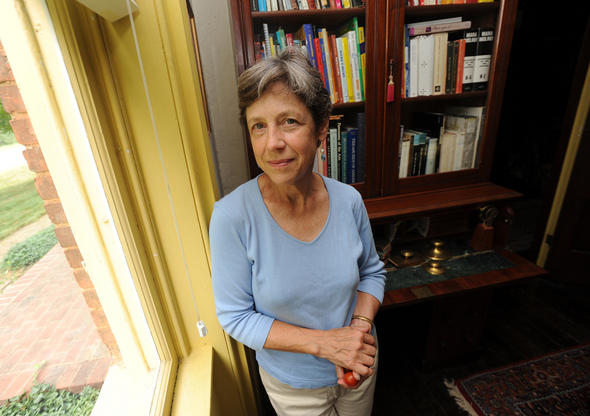Ypsilanti Heritage Foundation Historic Home Tour features 1839 Federal-style house wrapped in history

Jane Van Bolt inside her classic 1830s Greek revival home on Ann Arbor Road in Superior Township. The home is one of seven stops on Sunday's 33rd annual Ypsilanti Heritage Foundation Historic Home Tour.
Lon Horwedel | AnnArbor.com
Jane Van Bolt and her husband, John, spent years collecting antique furniture from the Federal Period (1780-1830), known for producing a classic, perfectly symmetrical design that celebrated the emerging nation of the United States. 


They filled their historic Victorian home in Ypsilanti with their Federal Period antiques until one day 23 years ago when Jane Van Bolt was driving through Superior Township and spotted a Federal house with a red brick face and Greek Revival details for sale.
“We weren’t in the market for a house,” Van Bolt said. “We had a newborn. But we saw it and bought it. It went with our furniture.”
Photo slideshow by Lon Horwedel | AnnArbor.com
While it was built in 1839, slight after the Federal Period had ended, it was nevertheless built in the Federal style.
They also bought a piece of history: The stately two-story home with cockled window glass and two front parlors was built by Esek Pray, who would become a significant player in the history of Michigan’s statehood. The house served as a tavern and as an inn on a stagecoach route as well as a farmhouse.
Today, a picture of Pray is hung at the side entryway. “He’s part of the house,” Van Bolt said.
The furniture, the house and the history will be open to the public Aug. 22 with the 33rd annual Ypsilanti Heritage Foundation Historic Home Tour. There will be seven stops on this year’s tour, including four 19th Century properties in Superior Township that have ties to each other and to Ypsilanti.
While the Van Bolts have been some changes to their four bedroom house over the years - they built an 800-foot addition that included a kitchen and only one of the eight fireplaces are now in use - much of the house remains intact, down to the wide poplar planked floors, original paint on an attic door, the mother of pearl inlay on the bottom stair post (legend has it that the mother of pearl was added when a mortgage was paid off, Van Bolt said) and the original key that fits into the front door lock.
There are modern touches: The whimsical tile from Spain that tops of kitchen island, the high ceiling of the kitchen, French doors that lead to the enclosed porch and side yard. The old kitchen had little natural light, seven doors and almost no cupboards. But the house remains true to its history.
Other changes have come - and gone. A Victorian era porch with its frilly brackets and trim was added, probably in the 1870s, but removed by the time the Van Bolts bought the house. The aging sugar maple trees in the front yard are seedlings in a photograph from around the time the porch was added.
In addition to the house, the Van Bolt’s collection of Federal antiques will also be on view, including a 1790s New Hampshire highboy chest made of maple and a poster bed from 1800 covered by a wool Jacquard coverlet from 1847.
Esek Pray was a well-to-do farmer/politician who attended the Michigan convention for statehood. He was a justice of the peace and a successful farmer and his son George was a member of the first University of Michigan graduating class. 

Esek Pray’s great-grandson Carl Esek Pray was the head of the Social Science and History Department at Eastern Michigan University from 1914 to 1938. Carl Esek Pray is one of the two men for which EMU ’s Pray-Harrold classroom building is named after.
If you go
The following properties are on Sunday’s 33rd annual Ypsilanti Heritage Foundation Historic Home Tour:
• 113 Buffalo St., Ypsilanti, an 1892 brick Queen Anne with Romanesque overtones.

• 47 N. Huron St., downtown Ypsilanti, the recently expanded and restored nonprofit Corner Health Center, located in an 1890s building.

• 211-215 W. Michigan Ave., Ypsilanti, three modern loft apartments located in the former Mack and Mack Furniture Building, one of the oldest structures in the city.

• 8605 W. Ann Arbor Rd. in Superior Township, the 1884 Italianate Geer house.

• 8755 W. Ann Arbor Rd. in Superior Township, the 1839 classic Federal-style Esek Pray house.

• 9105 W. Ann Arbor Rd. in Superior Township, the 1837 Upright and Wing-style McCormick farmhouse.

• 9981 W. Ann Arbor Rd. in Superior Township, the one-room Geer School built in 1880 and housing students until 1982.
Tickets can be purchased in advance for $10 at Haab’s Restaurant, Salt City Antiques, Norton’s Flowers, Nelson Amos Studio, Saxton’s Garden Center, Downtown Home and Garden and Superior Township Hall. They can be purchased for $12 the day of the tour in front of the Ypsilanti Historical Museum and at Haab’s.
The home tour is an event of the Ypsilanti Heritage Festival and runs from noon to 5 p.m. Aug. 22. For more information, go to www.yhf.org/. Tour organizers suggest beginning with the Ypsilanti locations before moving on to the Superior Township sites.


Comments
Linda Peck
Thu, Aug 18, 2011 : 10:44 a.m.
Wonderful house, wonderful event! Thank you for this most interesting article!
treetowncartel
Thu, Aug 19, 2010 : 10:37 p.m.
Talkl about impulse buying....I love it. Sounds like a diamond in the rough, nothing like old houses.